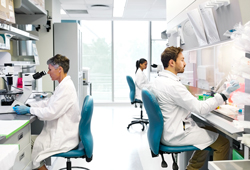 Academic or research institutions are at the core of early-stage innovation in the life sciences and biopharmaceutical industries. In order to gain access to the intellectual property generated or owned by those institutions, institutions typically offer to grant a license to its owned intellectual property to companies. In exchange for the license, institutions will look for consideration, which comes in a variety of forms. We can break down types of typical consideration into a few categories.
Academic or research institutions are at the core of early-stage innovation in the life sciences and biopharmaceutical industries. In order to gain access to the intellectual property generated or owned by those institutions, institutions typically offer to grant a license to its owned intellectual property to companies. In exchange for the license, institutions will look for consideration, which comes in a variety of forms. We can break down types of typical consideration into a few categories.
- License Issue Fee: Institutions may ask for an upfront fee for the grant of the license. This is a one-time payment paid at the signing of the license.
- Minimum Annual Royalties/Annual License Fees: Aside from the upfront fee, many institutions will ask for an annual “maintenance” fee. These can take the form of yearly lump sum payments, but can also sometimes be called “minimum annual royalties”. If these payments are considered minimum annual royalties, then the yearly fee is creditable against any royalties owed to the institution that year.
- Royalties: Institutions may ask for a percentage of the future sales of products that incorporate the intellectual property licensed. This comes in the form of on-going royalty payments. Typically, for most institutions, these are in the single-digits, but depend on the scope and breadth of the license.
- Development/Commercial Milestones: Institutions may ask for lump sum payments based on the achievement of certain developmental or commercial milestones by the company. For example, if a product that incorporates the intellectual property licensed from the institution receives FDA approval, the institution may ask for a lump sum payment upon such achievement.
- Sublicensing Income: Institutions like to ask for what we call “sublicense income”. Through sublicense income, the institution is entitled to a percentage of the consideration the company receives from a sublicensee, if the company sublicenses the institutions intellectual property to a third party. The percentage varies and usually decreases over time, but is typically in the single-digits to low double-digits.
- Patent Costs: If the company is taking an exclusive license, the institution will typically want the company to cover the costs of prosecuting any patents being licensed, those both already incurred and to be incurred in the future. In exchange, typically the company will have input in the future prosecution of the patents.
- Equity: Depending on the relationship of the institution and the company, some institutions may request equity in the company in exchange for the license grant.
The amount and frequency of the above categories will vary from license to license, and will depend on the scope and breadth of the license (e.g., exclusive v. non-exclusive, limited geography v. worldwide, narrow field v. all fields, etc.). There also may be consideration institutions will ask for, other than the above. We recommend connecting with your Goodwin licensing or commercial counsel to discuss what might be typical for the scope of license you intend to enter into.

